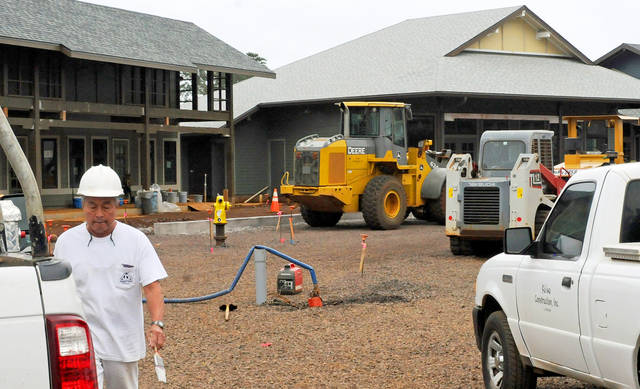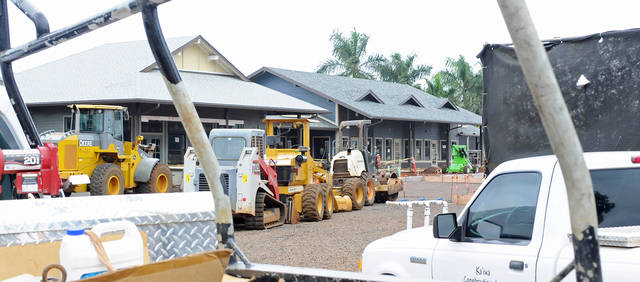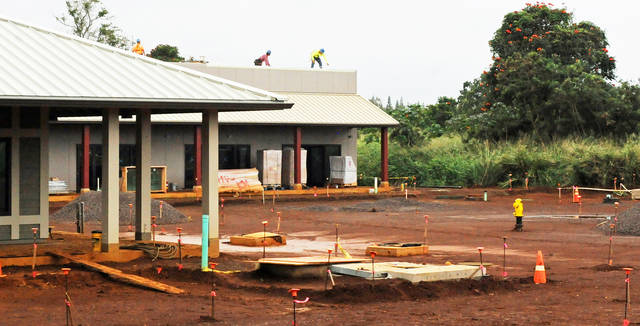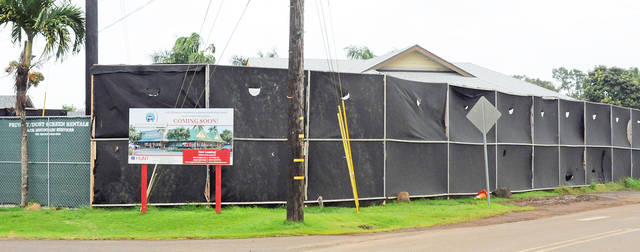The first new shopping center on the North Shore in 30 years is about to open in Kilauea, but two things will be missing when it does: the anchor supermarket operated by Foodland and a long-awaited new access road to Kilauea Town.
With luck, the market could open later this year, though building permits have still not been issued and there is no official date for start of construction. The road, which many Kilauea residents have long assumed would be completed before the shopping center opened and avert traffic congestion in the town center, won’t be constructed before 2020, at the earliest, and perhaps not at all.
By the time Kilauea Lighthouse Village center starts to open its storefronts — the timing is projected for April or May — it is likely the project will teach local residents a new four-letter word: “STIP.” That’s an acronym for “Statewide Transportation Improvement Program,” a 37-page document that ranks every highway construction and repair project in the islands in terms of its priority to be funded and constructed.
For at least 10 years, as Kilauea has grown, residents have made do with driving to Princeville to visit a supermarket, seven miles away, or even farther to Kapaa or Lihue to shop for nearly everything else. At least six years ago, the answer finally seemed at hand. Two large tracts of land near the Kilauea post office — vacant since the sugar days — would be converted into a shopping mall. It would include a market, restaurants and other retail outlets important to community life. There would be a community meeting room.
More important, perhaps, because the new shopping center is bound to create more traffic, especially along Kilauea Road, a primarily residential street, a new town access road — six-tenths of a mile long — would be constructed from Kuhio Highway. It would follow the route of a temporary construction road already in use.
Plans hit roadblocks
Bill and Denise Hay, owners of a very large, undeveloped, agriculture-zoned land that lies between the highway and Kilauea Town, agreed to donate land on which the new access road could be built, in exchange for zoning concessions that permit several new building lots on what is commonly called the Kilauea Plateau.
The Hays, who have homes in California and Hanalei, saw this as a step that would represent a win for all concerned. So did many (though by no means all) people in the Kilauea Neighborhood Association. The Hays even agreed to allow the temporary roadway so heavy trucks would not have to drive through town during construction.
The final land transfer, however, has not yet occurred.
“Denise and I are proceeding with our intentions to donate lands to the county for the bypass road,” Bill Hay said in a statement. “It should be finalized in the next couple of months.”
The shopping center project was formally announced in 2012, with the major drawing point a decision by the parent company of Foodland to open a new supermarket. The market will be smaller than most of the chain’s other stores, but carry a variety of goods similar to what may be found in other locations. The store will be 10,000 square feet and locally source as much of its goods as possible.
But as the years wore on, delays piled up. The Ace hardware store currently in Princeville initially agreed to take most of a building at Lighthouse Village, which as a result was designed with a steel frame, rather than the wood framing in the rest of the complex. The hardware store owner, however, grew impatient with the slow pace and renewed his lease in Princeville.
Then, after construction actually began in 2017, Foodland decided to redesign its store concept, requiring a larger building. The larger building, in turn, forced Foodland back to the architectural drawing boards.
“We have been working on the design of our market for quite some time and the redesign was necessary to expand the store to add more features,” said Sheryl Toda, spokesperson for the Sullivan Family of Companies, Foodland’s corporate parent.
Toda insisted that “summer 2018 is the target (for) opening,” but the date appears in doubt since building permits have yet to be issued.
As a result, Lighthouse Village will open without the market or road. Leasing has been slowed deliberately, according to Steve Colon, regional president of the Hunt Companies, the shopping center developer. Because the market will be the biggest draw, Colon said, developers want to slow the arrival of lessees until Lighthouse Village is getting maximum traffic.
“We’re not really in much of a hurry because we want to see the market get up and running,” Colon said.
“The rest of the buildings are almost done. I actually think the timing is going to work out fine.”
At the moment, the Verde restaurant group has signed a lease, as have a shave ice business and a coffee bar. An art gallery has also signed up and Colon said several letters of intent are in final review with potential lessees.
Hunt is responsible for upgrading the existing several hundred yards of the post office road so it could connect to the new town entry road, if it is ever built. There will be intersection modifications at Kilauea Road and Kaneke Street, where crews have already moved utility poles and set grading stakes to permit construction of a left-turn lane.
But the fly in the ointment is that the new town access road has not made the cut to be listed on the STIP list, which currently includes projects through 2020. The delay, officials said, is likely to be indefinite.
State officials say the county largely controls how projects are listed on the STIP list, but the county says the problem is really at the state level since some source of money has to be identified to build the new roadway. So far, none has been.
“We are focusing on maintaining the roads in our system versus building new roads,” said Shelly Kunishige, spokesperson for the Hawaii Department of Transportation.
Few would probably disagree that, at both the state and county levels, the repair backlog on existing streets and highways is staggering.
At the county, spokesperson Sarah Blane said entry on the STIP list would provide access to federal funds that could cover 80 percent of the construction cost. But, Blane said, “federal funds are limited and the process is highly competitive, so the county must be strategic in the projects we propose.”
“Both the federal and state governments have made it known that priority will be given to existing projects over new projects,” Blane continued. “The county has not yet attempted to include this new access road on the STIP, and is focusing instead on road repair and maintenance.”
This all leaves Colon feeling as if the shopping center developers have been left holding the bag. Colon is aware that, as word spreads through the community that the new access road will not be built for the foreseeable future, he knows most people will blame his company. But he said Hunt came into the project under the impression the access road arrangements were complete, not knowing that a seemingly insurmountable roadblock lay ahead.









Thank you for writing this article. Regarding the road, It would seem relevant to share some of the traffic numbers from visitors on their way to the lighthouse. I am not sure of the traffic threshold needed to get on the STIP radar but it is pretty staggering to learn how many people drive straight through a neighborhood to go see the lighthouse everyday.
Ready, fire, aim!! Kauai seems almost incapable of doing things that happen elsewhere with zero problems.
This is Exactly what most of us knew.The Hunt construction company made a lot of back room deals to get this project approved .!!!
When county planners came around a few years ago l absolutely screamed that the access road HAD to be built before the shopping center opens and that all traffic to the lighthouse should be driven to this access road to alleviate the terrible degrading conditions that the residents have had to deal with for the past 30 or so years. Goodbye Real Kilauea.
Perfect. All we need now is a Pizza Hut at Polihale and a 7-11 in Kalalau Valley and the island will pretty much be covered.
0.60 mile – on flat ground. About as easy/low-cost road construction imaginable. Should have made completion of the road a requirement for a building permit. And instead of a needed market, a few worthless junky stores go up. Yes, Kauai really needs another shave ice, coffee shop and art gallery. Smh.
Bill and Denise Hay are the most outstanding people I know and you should take advantage of their wonderful offer to get the road built through their property.
Anywhere else in the USA, all the development conditions are documented in the proposed projects environmental reports and to modify these conditions it would require recirculation of these reports for public review & comment…
Any project should mitigate its potential environmental impacts and traffic is a major impact!
If constructing the bypass road was a Development condition? Then how can the developer not fulfill his conditions? And still get his permits! Unbelievable…
Another amazing example of how Little government cares about community. All they care about is a viable tax base. Corrupt. And yet, Once again, the people here expected to lay down and take it.
Simple solution. Many in the community asked the county to require Hunt group to finance the road as they were adding much traffic. Now that Foodland is slowed and they still need building permits the county should not issue them until Hunt pays for road construction. The Hays have generously offered the land. The shopping center should offer the funding. Kilauea neighbors are watching to see whether the center will be a good neighbor and live up many years of past promises.
Perhaps Bill and Denise Hay can pay up to put in the road since they will get to put “buildings” around it that would require a zoning change in return for said road, which doesn’t seem
Very “outstanding@ to me. Politicians go to the slammer for zoning shenanigans.
What a joke.